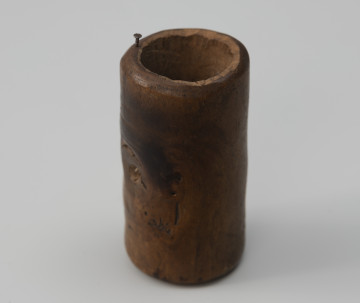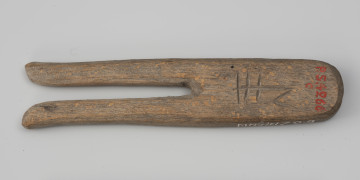
Flat netting gauge
1900 — 1950
National Museum in Szczecin
Part of the collection: Traditional fishing
The fish net needle, also known as a netting shuttle, used to tie the net is a simple plank made from a single piece of wood. Oval-shaped on one side, it is cut into a C-shape on the other. It has a grooved hole at the top from which a thin netting-needle protrudes to wrap the thread. Each fisherman had several of these in a range of sizes, allowing nets of different mesh sizes to be tied. A fish net needle about 20 cm long was used to tie the netting to the outside of the trammel, to the sledge or to the pick-up. Smaller ones were tied, for example, in long chains by their wings and leaders inside of the funnel. Before tying the net, the fisherman would prepare a set of different sized netting shuttle. He could have used single- or double-break knots. There were two ways of tying the net. The first way was to wrap the netting gauge twice with thread and make a knot, forming the first eye of the net, which was pulled off the netting gauge and hung on a hook. The fisherman would then place a netting gauge under the eyelet, and with the thread wound on the fish net needle, tie a loop, wrap the thread around the netting gauge, tighten another knot and slip the eyelet off the gauge. The second method produced a rectangular piece of netting. He would start to work on a strip equal to the length of the desired net. The fisherman made what is known as a blind eye loop to which he tied the first and subsequent ones along the strip. After completing the first row, he turned the strip and made a second row of eyelets. Each eyelet made last was linked to the one made first in the next row. In the collection of traditional fishing in the Pomeranian Ethnography Department of the National Museum in Szczecin, there are 28 fish net needles of various sizes. The piece on display, used by German fishermen, dates from the first half of the 20th century from the village of Pritter (Przytór, now part of Świnoujście). It was donated to the museum by a private individual in 1971. Małgorzata Kłosińska-Grzechowiak
Author / creator
Object type
netting shuttle
Technique
planing, drilling, cutting
Material
wood
Origin / acquisition method
donation
Creation time / dating
Creation / finding place
Owner
Muzeum Narodowe w Szczecinie
Identification number
Location / status

1900 — 1950
National Museum in Szczecin

1900 — 1920
National Museum in Szczecin

1890 — 1950
National Museum in Szczecin
DISCOVER this TOPIC
Museum of King Jan III's Palace at Wilanów
DISCOVER this PATH
Educational path